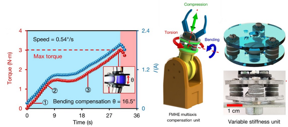Home > Press > Scientists develop self-tunable electro-mechano responsive elastomers
 |
| The FMHE-based compensator and its torque-time and current-time curves.
CREDIT Image by YUN Guolin et al. |
Abstract:
Recently, a team led by Prof. ZHANG Shiwu from the University of Science and Technology of China (USTC) and their collaborators from UK and Australia developed a new electro-mechano responsive elastomer that autonomously adjust stiffness, conductivity and strain sensitivity in response to changes in external mechanical loads and electrical signals. Their research was published in Science Advances.
Scientists develop self-tunable electro-mechano responsive elastomers
Hefei, China | Posted on March 3rd, 2023
Nowadays, more and more application scenarios like soft robotics and medical surgical equipment call for self-tunable intelligent materials. A widely adopted solution is composite material composed of low melting point alloy and elastic polymer. However, such material is unable to automatically respond to external changes and can only switch between conductive and insulating states.
To fill this gap, the team developed a Fields metal-filled hybrid elastomer (FMHE) composed of nickel (Ni) microparticles, low melting point Fields metal (FM) and polymer matrix. The multi-filler conductive network formed by spiked Ni particles and FM particles enables the conductivity of the FMHE to grow exponentially under different mechanical loads such as compression, twist and bend. When FMHE is heated to 60℃ and above, the FM particles within are melted. Melted FM droplets cant form conductive paths like solid particles, but deforms with polymer matrix under load, which significantly reduces the elastic modulus, conductivity and strain sensitivity. Since the materials electrical resistance decrease as it deforms, self-tunable conductivity and stiffness can be achieved by heating and applying certain pressure on FMHE.
Combining the variable resistance and stiffness properties, the research team developed a self-triggered multiaxis compliance compensator for robotic manipulators, which can compensate for positional and angular errors through its deformation, avoiding damage to equipment in complex operating environments. The teams FMHE-based device showed greater compensation capability than that of current commercial systems (bending angle of 16.5° over 1.1°). Furthermore, the team developed a resettable current-liming fuse based on FMHE. When reaching the fusing current, the resistance of the fuse can increase 1000 times in 0.1 seconds to cut off the circuit and reset in 10 seconds.
The intelligent materials developed by the team enabled synergistic utilization of tunable electrical and mechanical properties, showing great potential in its application to the next generation soft robotics and electronic devices.
####
For more information, please click here
Contacts:
Jane Fan
University of Science and Technology of China
Copyright © University of Science and Technology of China
If you have a comment, please Contact us.
Issuers of news releases, not 7th Wave, Inc. or Nanotechnology Now, are solely responsible for the accuracy of the content.
News and information
![]()
Scientists push the boundaries of manipulating light at the submicroscopic level March 3rd, 2023
![]()
Lipid nanoparticles highly effective in gene therapy March 3rd, 2023
Possible Futures
![]()
Recent progress of carbon-based non-noble metal single-atom catalysts for energy conversion electrocatalysis March 3rd, 2023
Chip Technology
![]()
New study opens the door to ultrafast 2D devices that use nonequilibrium exciton superdiffusion February 10th, 2023
![]()
Approaching the terahertz regime: Room temperature quantum magnets switch states trillions of times per second January 20th, 2023
Discoveries
![]()
Recent progress of carbon-based non-noble metal single-atom catalysts for energy conversion electrocatalysis March 3rd, 2023
![]()
Getting drugs across the blood-brain barrier using nanoparticles March 3rd, 2023
Materials/Metamaterials
![]()
Make them thin enough, and antiferroelectric materials become ferroelectric February 10th, 2023
![]()
Rice turns asphaltene into graphene for composites: Flashed byproduct of crude oil could bolster materials, polymer inks November 18th, 2022
![]()
How 2D materials expand: New technique that accurately measures how atom-thin materials expand when heated could help engineers develop faster, more powerful electronic devices November 18th, 2022
Announcements
![]()
Recent progress of carbon-based non-noble metal single-atom catalysts for energy conversion electrocatalysis March 3rd, 2023
![]()
Getting drugs across the blood-brain barrier using nanoparticles March 3rd, 2023
Interviews/Book Reviews/Essays/Reports/Podcasts/Journals/White papers/Posters
![]()
Recent progress of carbon-based non-noble metal single-atom catalysts for energy conversion electrocatalysis March 3rd, 2023
![]()
Getting drugs across the blood-brain barrier using nanoparticles March 3rd, 2023










